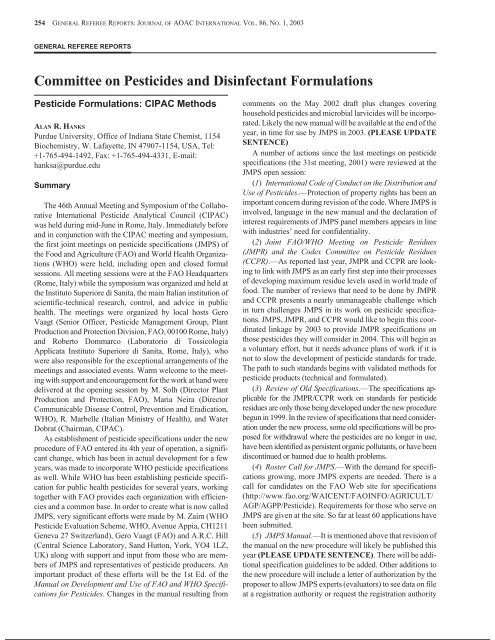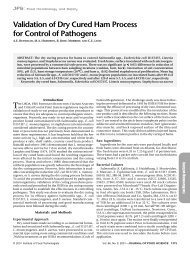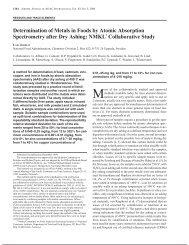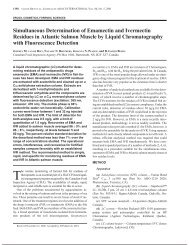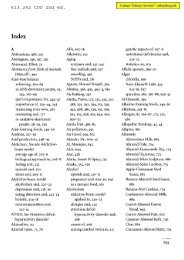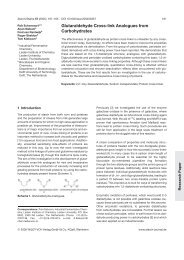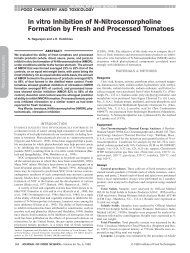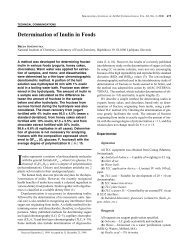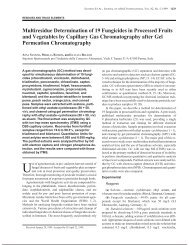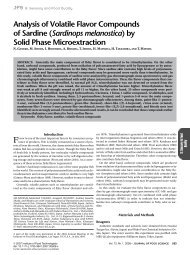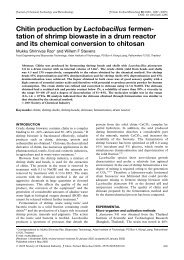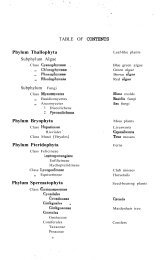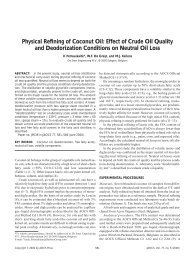Committee on Pesticides and Disinfectant Formulations
Committee on Pesticides and Disinfectant Formulations
Committee on Pesticides and Disinfectant Formulations
Create successful ePaper yourself
Turn your PDF publications into a flip-book with our unique Google optimized e-Paper software.
254 GENERAL REFEREE REPORTS:JOURNAL OF AOAC INTERNATIONAL VOL. 86, NO. 1, 2003<br />
GENERAL REFEREE REPORTS<br />
<str<strong>on</strong>g>Committee</str<strong>on</strong>g> <strong>on</strong> <strong>Pesticides</strong> <strong>and</strong> <strong>Disinfectant</strong> Formulati<strong>on</strong>s<br />
Pesticide Formulati<strong>on</strong>s: CIPAC Methods<br />
ALAN R. HANKS<br />
Purdue University, Office of Indiana State Chemist, 1154<br />
Biochemistry, W. Lafayette, IN 47907-1154, USA, Tel:<br />
+1-765-494-1492, Fax: +1-765-494-4331, E-mail:<br />
hanksa@purdue.edu<br />
Summary<br />
The 46th Annual Meeting <strong>and</strong> Symposium of the Collaborative<br />
Internati<strong>on</strong>al Pesticide Analytical Council (CIPAC)<br />
was held during mid-June in Rome, Italy. Immediately before<br />
<strong>and</strong> in c<strong>on</strong>juncti<strong>on</strong> with the CIPAC meeting <strong>and</strong> symposium,<br />
the first joint meetings <strong>on</strong> pesticide specificati<strong>on</strong>s (JMPS) of<br />
the Food <strong>and</strong> Agriculture (FAO) <strong>and</strong> World Health Organizati<strong>on</strong>s<br />
(WHO) were held, including open <strong>and</strong> closed formal<br />
sessi<strong>on</strong>s. All meeting sessi<strong>on</strong>s were at the FAO Headquarters<br />
(Rome, Italy) while the symposium was organized <strong>and</strong> held at<br />
the Instituto Superiore di Sanita, the main Italian instituti<strong>on</strong> of<br />
scientific-technical research, c<strong>on</strong>trol, <strong>and</strong> advice in public<br />
health. The meetings were organized by local hosts Gero<br />
Vaagt (Senior Officer, Pesticide Management Group, Plant<br />
Producti<strong>on</strong> <strong>and</strong> Protecti<strong>on</strong> Divisi<strong>on</strong>, FAO, 00100 Rome, Italy)<br />
<strong>and</strong> Roberto Dommarco (Laboratorio di Tossicologia<br />
Applicata Instituto Superiore di Sanita, Rome, Italy), who<br />
were also resp<strong>on</strong>sible for the excepti<strong>on</strong>al arrangements of the<br />
meetings <strong>and</strong> associated events. Warm welcome to the meeting<br />
with support <strong>and</strong> encouragement for the work at h<strong>and</strong> were<br />
delivered at the opening sessi<strong>on</strong> by M. Solh (Director Plant<br />
Producti<strong>on</strong> <strong>and</strong> Protecti<strong>on</strong>, FAO), Maria Neira (Director<br />
Communicable Disease C<strong>on</strong>trol, Preventi<strong>on</strong> <strong>and</strong> Eradicati<strong>on</strong>,<br />
WHO), R. Marbelle (Italian Ministry of Health), <strong>and</strong> Water<br />
Dobrat (Chairman, CIPAC).<br />
As establishment of pesticide specificati<strong>on</strong>s under the new<br />
procedure of FAO entered its 4th year of operati<strong>on</strong>, a significant<br />
change, which has been in actual development for a few<br />
years, was made to incorporate WHO pesticide specificati<strong>on</strong>s<br />
as well. While WHO has been establishing pesticide specificati<strong>on</strong><br />
for public health pesticides for several years, working<br />
together with FAO provides each organizati<strong>on</strong> with efficiencies<br />
<strong>and</strong> a comm<strong>on</strong> base. In order to create what is now called<br />
JMPS, very significant efforts were made by M. Zaim (WHO<br />
Pesticide Evaluati<strong>on</strong> Scheme, WHO, Avenue Appia, CH1211<br />
Geneva 27 Switzerl<strong>and</strong>), Gero Vaagt (FAO) <strong>and</strong> A.R.C. Hill<br />
(Central Science Laboratory, S<strong>and</strong> Hutt<strong>on</strong>, York, YO4 1LZ,<br />
UK) al<strong>on</strong>g with support <strong>and</strong> input from those who are members<br />
of JMPS <strong>and</strong> representatives of pesticide producers. An<br />
important product of these efforts will be the 1st Ed. of the<br />
Manual <strong>on</strong> Development <strong>and</strong> Use of FAO <strong>and</strong> WHO Specificati<strong>on</strong>s<br />
for <strong>Pesticides</strong>. Changes in the manual resulting from<br />
comments <strong>on</strong> the May 2002 draft plus changes covering<br />
household pesticides <strong>and</strong> microbial larvicides will be incorporated.<br />
Likely the new manual will be available at the end of the<br />
year, in time for use by JMPS in 2003. (PLEASE UPDATE<br />
SENTENCE)<br />
A number of acti<strong>on</strong>s since the last meetings <strong>on</strong> pesticide<br />
specificati<strong>on</strong>s (the 31st meeting, 2001) were reviewed at the<br />
JMPS open sessi<strong>on</strong>:<br />
(1) Internati<strong>on</strong>al Code of C<strong>on</strong>duct <strong>on</strong> the Distributi<strong>on</strong> <strong>and</strong><br />
Use of <strong>Pesticides</strong>.—Protecti<strong>on</strong> of property rights has been an<br />
important c<strong>on</strong>cern during revisi<strong>on</strong> of the code. Where JMPS is<br />
involved, language in the new manual <strong>and</strong> the declarati<strong>on</strong> of<br />
interest requirements of JMPS panel members appears in line<br />
with industries’ need for c<strong>on</strong>fidentiality.<br />
(2) Joint FAO/WHO Meeting <strong>on</strong> Pesticide Residues<br />
(JMPR) <strong>and</strong> the Codex <str<strong>on</strong>g>Committee</str<strong>on</strong>g> <strong>on</strong> Pesticide Residues<br />
(CCPR).—As reported last year, JMPR <strong>and</strong> CCPR are looking<br />
to link with JMPS as an early first step into their processes<br />
of developing maximum residue levels used in world trade of<br />
food. The number of reviews that need to be d<strong>on</strong>e by JMPR<br />
<strong>and</strong> CCPR presents a nearly unmanageable challenge which<br />
in turn challenges JMPS in its work <strong>on</strong> pesticide specificati<strong>on</strong>s.<br />
JMPS, JMPR, <strong>and</strong> CCPR would like to begin this coordinated<br />
linkage by 2003 to provide JMPR specificati<strong>on</strong>s <strong>on</strong><br />
those pesticides they will c<strong>on</strong>sider in 2004. This will begin as<br />
a voluntary effort, but it needs advance plans of work if it is<br />
not to slow the development of pesticide st<strong>and</strong>ards for trade.<br />
The path to such st<strong>and</strong>ards begins with validated methods for<br />
pesticide products (technical <strong>and</strong> formulated).<br />
(3) Review of Old Specificati<strong>on</strong>s.—The specificati<strong>on</strong>s applicable<br />
for the JMPR/CCPR work <strong>on</strong> st<strong>and</strong>ards for pesticide<br />
residues are <strong>on</strong>ly those being developed under the new procedure<br />
begun in 1999. In the review of specificati<strong>on</strong>s that need c<strong>on</strong>siderati<strong>on</strong><br />
under the new process, some old specificati<strong>on</strong>s will be proposed<br />
for withdrawal where the pesticides are no l<strong>on</strong>ger in use,<br />
have been identified as persistent organic pollutants, or have been<br />
disc<strong>on</strong>tinued or banned due to health problems.<br />
(4) Roster Call for JMPS.—With the dem<strong>and</strong> for specificati<strong>on</strong>s<br />
growing, more JMPS experts are needed. There is a<br />
call for c<strong>and</strong>idates <strong>on</strong> the FAO Web site for specificati<strong>on</strong>s<br />
(http://www.fao.org/WAICENT/FAOINFO/AGRICULT/<br />
AGP/AGPP/Pesticide). Requirements for those who serve <strong>on</strong><br />
JMPS are given at the site. So far at least 60 applicati<strong>on</strong>s have<br />
been submitted.<br />
(5) JMPS Manual.—It is menti<strong>on</strong>ed above that revisi<strong>on</strong> of<br />
the manual <strong>on</strong> the new procedure will likely be published this<br />
year (PLEASE UPDATE SENTENCE). There will be additi<strong>on</strong>al<br />
specificati<strong>on</strong> guidelines to be added. Other additi<strong>on</strong>s to<br />
the new procedure will include a letter of authorizati<strong>on</strong> by the<br />
proposer to allow JMPS experts (evaluators) to see data <strong>on</strong> file<br />
at a registrati<strong>on</strong> authority or request the registrati<strong>on</strong> authority
to provide feedback in comparis<strong>on</strong> of data submitted to JMPS<br />
<strong>and</strong> registrati<strong>on</strong> data <strong>on</strong> file; identificati<strong>on</strong> by the proposer of<br />
links, if any, between relevant impurities <strong>and</strong> submitted<br />
ecotoxicological <strong>and</strong> toxicological data; attachment of methods<br />
by proposers for methods that are not AOAC or CIPAC;<br />
<strong>and</strong> WHO recommendati<strong>on</strong>s <strong>on</strong> efficacy may be used where<br />
such exists to support specificati<strong>on</strong>s.<br />
Again this year, specificati<strong>on</strong>s proposed as new, revised<br />
from old specificati<strong>on</strong>s, carried over from prior reviews or additi<strong>on</strong>s<br />
to existing, new procedure specificati<strong>on</strong> were c<strong>on</strong>sidered<br />
in Rome. Records of the reviews were made by<br />
J. Gillespie (UK Pesticide Safety Directorate, York, UK) <strong>and</strong><br />
A. Kouppari (Department of Agriculture, Pesticide Laboratories,<br />
Nicosia, Cyprus), while guidance <strong>and</strong> leadership were<br />
provided by A.R.C. Hill (Chairman, JMPS), Gero Vaagt<br />
(FAO), <strong>and</strong> M. Zimme (WHO), with industry leadership input<br />
by Thomas S. Woods (Crop Life Internati<strong>on</strong>al/DuP<strong>on</strong>t). Approvals<br />
from the Rome meetings will be individually posted<br />
as finalized <strong>on</strong> the FAO Worldwide Web pages of<br />
http://www.fao.org/Waicent/FAOINFO/AGRICULT/AGP/<br />
AGPP/Pesticide <strong>and</strong> by WHO where applicable at<br />
http://www.who.int/ctd/whopes/specificati<strong>on</strong>s<strong>and</strong>methods.htm.<br />
The FAO site currently has 14 postings of new procedure<br />
specificati<strong>on</strong>s, 4 of which are from 2001.<br />
An important general principle related to pesticide specificati<strong>on</strong>s<br />
<strong>and</strong> the chemical methods for product active ingredient<br />
identificati<strong>on</strong> received significant discussi<strong>on</strong> <strong>and</strong> emphasis<br />
as numerous isomer specific pesticides were reviewed.<br />
While isomer specific analytical methods are most desirable,<br />
such may not always be practical; however, as a starting <strong>and</strong><br />
receiving point check for goods in trade, isomer specific identity<br />
tests have great significance in relati<strong>on</strong> to product quality,<br />
potential envir<strong>on</strong>mental impact, <strong>and</strong> surely to value for funds<br />
expended. Thus, adequate emphasis was given <strong>and</strong> should be<br />
expected for the future, where applicable, <strong>on</strong> the specificity of<br />
identity test in CIPAC methods <strong>and</strong> pesticide specificati<strong>on</strong> review<br />
by JMPS.<br />
The CIPAC Symposium was held after the JMPS, but before<br />
the CIPAC technical meetings. Approximately 80 scientists<br />
from around the world were in attendance. This year the<br />
symposium c<strong>on</strong>sisted of 10 papers <strong>on</strong> regulatory, envir<strong>on</strong>mental,<br />
<strong>and</strong> analytical topics including: European Uni<strong>on</strong> pesticide<br />
legislati<strong>on</strong>, the WHO pesticide evaluati<strong>on</strong> scheme,<br />
chiral stability of pesticides in the envir<strong>on</strong>ment, near infrared<br />
spectroscopy <strong>and</strong> capillary electrophoreses applicati<strong>on</strong>s in<br />
pesticide analysis, <strong>and</strong> measurement of release properties of<br />
microencapsulated pesticides. Determinati<strong>on</strong> of the distributi<strong>on</strong><br />
of active ingredient between that which is free <strong>and</strong> that<br />
which is encapsulated is of great importance, although usually<br />
quite under appreciated. Whether encapsulated for the purpose<br />
of improved user safety, time extended effectiveness or<br />
obtaining efficacy at lower rates of applicati<strong>on</strong>/less frequent<br />
applicati<strong>on</strong>, integrity <strong>and</strong> c<strong>on</strong>tent of the encapsulated porti<strong>on</strong><br />
of active ingredient can be a significant element of product<br />
quality. A.R.C. Hill <strong>and</strong> D.J. Hamilt<strong>on</strong> (Animal <strong>and</strong> Plant<br />
Health Service, Department of Primary Industries, Brisbane,<br />
Australia) were co-moderators of the Symposium sessi<strong>on</strong>s,<br />
GENERAL REFEREE REPORTS:JOURNAL OF AOAC INTERNATIONAL VOL. 86, NO. 1, 2003 255<br />
with D. J. Hamilt<strong>on</strong> c<strong>on</strong>cluding the day with a summary of the<br />
program.<br />
The 2 days of CIPAC technical sessi<strong>on</strong>s were both busy<br />
<strong>and</strong> well organized by the CIPAC Secretary, M.D. Müller<br />
(Swiss Federal Research Stati<strong>on</strong>, CH-8820 Wädenswil, Switzerl<strong>and</strong>),<br />
in his first <strong>and</strong> <strong>on</strong>ly year for this role as he is assuming<br />
the reins of CIPAC as Chairman this year. The new<br />
CIPAC Secretary is L. Bura (Plant Health <strong>and</strong> Soil Protecti<strong>on</strong><br />
Stati<strong>on</strong>, PF 340, Budaörsi ut 141, 1118 Budapest, Hungary).<br />
From review of the methods <strong>and</strong> studies presented at the meeting,<br />
the following acti<strong>on</strong>s were taken: 5 analytical methods<br />
were accepted as provisi<strong>on</strong>al CIPAC methods as was <strong>on</strong>e<br />
method extensi<strong>on</strong>; 4 previously accepted provisi<strong>on</strong>al analytical<br />
methods were accepted as full CIPAC methods, as were 4<br />
method extensi<strong>on</strong>s; <strong>and</strong> 2 physical test methods were accepted<br />
as provisi<strong>on</strong>al. These method acti<strong>on</strong>s were made under the fine<br />
leadership of retiring CIPAC Chairman, Walter Dobrat, who<br />
served as CIPAC Assistant Secretary for several years, making<br />
significant c<strong>on</strong>tributi<strong>on</strong>s <strong>on</strong> editorial efforts for CIPAC H<strong>and</strong>books.<br />
Dobrat was succeeded by Joe Gillespie as Assistant Secretary<br />
in 2000, who is succeeded by Ana Kouppori this year.<br />
CIPAC will miss Dobrat <strong>and</strong> Gillespie, while entering a new<br />
year with an entirely new group of officers, including the treasurer,<br />
Bryan E. Hocken, who replaced M.J.P. Harringt<strong>on</strong> at the<br />
close of the 2001 meeting in Bangkok.<br />
During the CIPAC management meeting, it was agreed to<br />
revise its cooperative agreement with AOAC. Similarly, under<br />
c<strong>on</strong>siderati<strong>on</strong> is a like agreement <strong>on</strong> physical methods<br />
with ASTM.<br />
Four small scale or preliminary analytical studies, which<br />
will very likely be the subject of full collaborative studies this<br />
year, were reported at the CIPAC meeting: d-allethrin, parathi<strong>on</strong>-methyl,<br />
d-phenothrin, <strong>and</strong> prallethrin. Laboratories who<br />
are interested in receiving notice of these <strong>and</strong> other CIPAC<br />
studies, but not routinely receiving CIPAC study informati<strong>on</strong><br />
sheets, should notify this General Referee <strong>and</strong> be placed <strong>on</strong> the<br />
list of laboratories to be provided announcements of CIPAC<br />
studies. Approximately 20 new CIPAC methods plus extensi<strong>on</strong>s<br />
may be ready for the next CIPAC H<strong>and</strong>book, G, by the<br />
end of the year (PLEASE UPDATE SENTENCE). Informati<strong>on</strong><br />
needed for ordering CIPAC h<strong>and</strong>books is available <strong>on</strong> the<br />
CIPAC home page (http://www.cipac.org, click <strong>on</strong> “CIPAC<br />
Publicati<strong>on</strong>s”).<br />
Selected Topics<br />
CIPAC Provisi<strong>on</strong>al Methods<br />
Cycloxydim (Selective Postemergence Grass Herbicide, a<br />
Graminicide): Nineteen of 21 laboratories, representing 12<br />
countries, returned data after analysis of 5 samples representing<br />
5 materials: 3 emulsifiable c<strong>on</strong>centrates (EC), <strong>on</strong>e technical<br />
c<strong>on</strong>centrate (TK), <strong>and</strong> <strong>on</strong>e technical material (TC). (OK?<br />
TC ALSO USED FOR TECHNICAL CONCENTRATES<br />
IN NEXT PARAGRAPH) Analyses were performed using<br />
an LC phenyl column with detecti<strong>on</strong> at 280 nm <strong>and</strong> electr<strong>on</strong>ic<br />
integrator or data system plus external st<strong>and</strong>ardizati<strong>on</strong>. One
256 GENERAL REFEREE REPORTS:JOURNAL OF AOAC INTERNATIONAL VOL. 86, NO. 1, 2003<br />
outlier result was found in statistical evaluati<strong>on</strong> of the data<br />
from analysis of each of 4 of the 5 test samples. Except for <strong>on</strong>e<br />
of the test samples, method performance was quite acceptable<br />
without outlier removal. This German PAC study was directed<br />
by R. Eisert <strong>and</strong> G. Genari, both of BASF (Agricultural<br />
Center Limburgerhof, Crop Protecti<strong>on</strong> Development, PO Box<br />
120, D-67114 Limburgerhof, Germany), with presentati<strong>on</strong> by<br />
G. Genari.<br />
Esfenvolerate (Broad Spectrum Insecticide): After a successful<br />
small scale study reported at the 45th CIPAC meeting,<br />
Ritsuko Furuta (Sumitomo Chemical Co., Ltd., Envir<strong>on</strong>mental<br />
Health Science Laboratory, 3-1-98, Kasugade-naka,<br />
K<strong>on</strong>ohanaku, Osaka, Japan) directed <strong>and</strong> presented a full collaborative<br />
under the Japanese PAC. Capillary GC was used to<br />
separate esfenvalerate, the S,S <strong>and</strong> R,R isomers in <strong>on</strong>e peak,<br />
separate from the R,S <strong>and</strong> S,R isomers, for detecti<strong>on</strong> by FID<br />
<strong>and</strong> area integrati<strong>on</strong> by electr<strong>on</strong>ic integrator or data system. Of<br />
the 12 laboratories, located in 8 countries, participating <strong>and</strong> returning<br />
data sets, 2 were found to have c<strong>on</strong>sistently produced<br />
Table 1. Summary of decisi<strong>on</strong>s made at the 46th CIPAC meeting<br />
Code No. Name Status<br />
outlier results <strong>on</strong> the 5 test samples analyzed of 5 materials: 2<br />
of technical c<strong>on</strong>centrates (TC) (OK?) <strong>and</strong> 3 of ultra low volume<br />
(UL) formulati<strong>on</strong>s. Method performance was acceptable<br />
for the TC test samples without removal of outliers, but c<strong>on</strong>siderably<br />
improved after removal, while performance was<br />
<strong>on</strong>ly marginally acceptable for <strong>on</strong>e UL <strong>and</strong> unacceptable for<br />
<strong>on</strong>e before removal of outliers. Method performance was acceptable<br />
for all UL formulati<strong>on</strong>s after outlier removal.<br />
This study also included an LC normal-phase method for<br />
determinati<strong>on</strong> of the R,R isomer of esfenvolerate as a percentage<br />
of the R,R <strong>and</strong> S,S total, which was c<strong>on</strong>sistently around<br />
1% of the combined GC peak of R,R <strong>and</strong> S,S isomers; however,<br />
the relative st<strong>and</strong>ard deviati<strong>on</strong>s were rather high, as<br />
might be somewhat accounted for <strong>and</strong> expected at such a low<br />
level. The LC method does provide c<strong>on</strong>firmati<strong>on</strong> of identity<br />
relative to expected R,R <strong>and</strong> S,S isomer compositi<strong>on</strong>.<br />
Icaridin (Repellent): Sixteen laboratories from 9 countries<br />
volunteered for this study <strong>and</strong> 13 returned data sets <strong>on</strong> 2 technical<br />
materials (TC) (OK?) <strong>and</strong> 3 loti<strong>on</strong> formulati<strong>on</strong>s. Analy-<br />
12 Malathi<strong>on</strong> The capillary GC method for malathi<strong>on</strong> <strong>and</strong> formulati<strong>on</strong>s (TC, EC, EW, DP),<br />
CIPAC/4267R, has been accepted as provisi<strong>on</strong>al.<br />
171 Oxydemet<strong>on</strong>-methyl The LC provisi<strong>on</strong>al method for oxydemet<strong>on</strong>-methyl <strong>and</strong> formulati<strong>on</strong>s (TC, EC, SL),<br />
CIPAC/4247, has been accepted as full.<br />
221 Chlorpyrifos The extensi<strong>on</strong> of the AOAC-CIPAC LC method for chlorpyrifos to ultra low volume<br />
formulati<strong>on</strong>s (UL), CIPAC IC, has been accepted provisi<strong>on</strong>al.<br />
391 Chlorsulfur<strong>on</strong> The extensi<strong>on</strong> of the CIPAC LC method for chlorsulfur<strong>on</strong> to wettable powders (WP),<br />
CIPAC H, p89 (CIPAC/4257), has been made full.<br />
441 Metsulfur<strong>on</strong>-methyl The extensi<strong>on</strong> of the CIPAC LC method for metsulfur<strong>on</strong>-methyl wettable powders (WP),<br />
CIPAC H, p205 (CIPAC/4256), has been made full.<br />
471 Etofenprox The capillary GC method for etofenprox technical <strong>and</strong> formulati<strong>on</strong>s (WP, EC, OW),<br />
CIPAC/4239, has been made full.<br />
481 Esfinvalerate The capillary GC <strong>and</strong> the LC method for esfinvalerate technical <strong>and</strong> formulati<strong>on</strong>s (UL),<br />
CIPAC/4269, have been made provisi<strong>on</strong>al.<br />
502 Bensulfur<strong>on</strong>-methyl The extensi<strong>on</strong> of the CIPAC LC method to bensulfur<strong>on</strong> (OR BENSULFURON-METHYL?)<br />
wettable powders (WP), CIPAC/4258, has been made full.<br />
510 Cycloxydim The LC method for cycloxydim technical <strong>and</strong> formulati<strong>on</strong>s (TK, EC), CIPAC/4287, has<br />
been made provisi<strong>on</strong>al.<br />
546 Tribenur<strong>on</strong>-methyl The LC method for tribenur<strong>on</strong>-methyl technical <strong>and</strong> formulati<strong>on</strong>s (DF, WG), CIPAC/4283,<br />
has been made provisi<strong>on</strong>al.<br />
568 Kresoxim-methyl The LC provisi<strong>on</strong>al method for kresoxim-methyl technical <strong>and</strong> formulati<strong>on</strong>s (WG, SC, SE),<br />
CIPAC/4250, has been made full.<br />
582 Imidacloprid The LC method for imidacloprid FS formulati<strong>on</strong>, CIPAC/4253, has been made full.<br />
599 Niclosamide The extensi<strong>on</strong> of the CIPAC LC method for niclosamide formulati<strong>on</strong> suspensi<strong>on</strong><br />
c<strong>on</strong>centrate (SC), CIPAC/4252, has been made full.<br />
740 Icaridin The LC method for icaridin technical <strong>and</strong> formulati<strong>on</strong> (loti<strong>on</strong>), CIPAC/4248, has been<br />
made provisi<strong>on</strong>al.<br />
MT 187 Particle size analysis by laser diffracti<strong>on</strong> The method for determinati<strong>on</strong> of particle size by laser diffracti<strong>on</strong> of pesticide formulati<strong>on</strong>s<br />
(WP, WG, SC), CIPAC/4279, has been made provisi<strong>on</strong>al.<br />
MT 178 Attriti<strong>on</strong> resistance The method for determinati<strong>on</strong> of attriti<strong>on</strong> resistance of granules, CIPAC/4280, has been<br />
made provisi<strong>on</strong>al.
ses were performed using capillary GC for separati<strong>on</strong>, flame<br />
i<strong>on</strong>izati<strong>on</strong> for detecti<strong>on</strong> <strong>and</strong> peak area ratio determinati<strong>on</strong> with<br />
the internal st<strong>and</strong>ard using an electr<strong>on</strong>ic integrati<strong>on</strong> or data<br />
system. No result was removed for either TC <strong>and</strong> <strong>on</strong>ly 4 results<br />
were removed for the 3 loti<strong>on</strong>s analyzed after statistical<br />
evaluati<strong>on</strong> of all data sets. Method performance was excellent<br />
for the TC products <strong>and</strong> adequate for the loti<strong>on</strong> formulati<strong>on</strong>s<br />
in this study directed under the German PAC <strong>and</strong> presented at<br />
CIPAC by T. Werner (Bayer AG, ZF-ZAD, Postfach 100140,<br />
D-41538 Dormagen, Germany).<br />
Malathi<strong>on</strong> (Insecticide): One technical material (TC)<br />
(OK?), <strong>on</strong>e emulsifiable c<strong>on</strong>centrate (EC), 2 oil in water<br />
emulsi<strong>on</strong>s (EW), <strong>and</strong> <strong>on</strong>e dustable powder (DP) were analyzed<br />
by separati<strong>on</strong> <strong>on</strong> capillary GC, flame i<strong>on</strong>izati<strong>on</strong> detecti<strong>on</strong>,<br />
internal st<strong>and</strong>ard peak area ratios, with electr<strong>on</strong>ic integrator<br />
or data system integrati<strong>on</strong> of peak areas for<br />
quantitati<strong>on</strong>. Twenty-three laboratories representing 19 countries<br />
returned data sets. Statistical analysis identified <strong>on</strong>ly 2 results<br />
from <strong>on</strong>e laboratory that were removed as outliers.<br />
Method performance was satisfactory for all materials ana-<br />
GENERAL REFEREE REPORTS:JOURNAL OF AOAC INTERNATIONAL VOL. 86, NO. 1, 2003 257<br />
lyzed in this study directed by Elsa V. Sorensen (Cheminova<br />
A/S, PO Box 9, DK-7620 Lemvig, Denmark), who also presented<br />
the results at CIPAC.<br />
Tribenur<strong>on</strong>-methyl (Broadleaf Herbicide): No fewer than<br />
19 results remained for each material after outlier removal<br />
from statistical analysis of the data returned by 23 laboratories<br />
from 14 countries. Analysis of 2 technical materials (TC)<br />
(OK?), 2 dry flowables (DF), <strong>and</strong> 2 water dispersible granules<br />
(WG) was c<strong>on</strong>ducted using LC–reversed-phase chromatography<br />
with internal st<strong>and</strong>ard, detecti<strong>on</strong> at 254 nm <strong>and</strong> peak area<br />
determinati<strong>on</strong> with electr<strong>on</strong>ic integrati<strong>on</strong> or data system.<br />
Good method performance was found for all test samples analyzed<br />
in this study directed <strong>and</strong> presented by David E.<br />
Brennan (DuP<strong>on</strong>t Crop Protecti<strong>on</strong>, Stine-Haskill Research<br />
Center, PO Box 30, Newark, DE 19714-0030, USA).<br />
Recommendati<strong>on</strong>s<br />
N<strong>on</strong>e.


